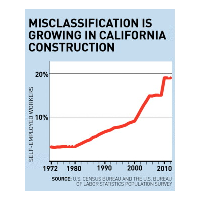Construction Industry Underpays Thousands of “Informal” California Workers
 (graphic: Engineering News-Record)
(graphic: Engineering News-Record)
The “sharing economy” is fueled by a lower-wage labor force toiling in an underground economy, unprotected legally or socially in their jobs. But long before there were smartphones to facilitate practices that drove down labor compensation, the construction agency was blazing new trails.
A new study, “Sinking Underground” (pdf) by the Economic Roundtable, says that one in six jobs in California’s $152-billion construction industry, more than 143,900 workers, were in the underground economy in 2011. Of those, 104,100 jobs had unreported wages and salaries and 39,800 involved employees who were misclassified as independent contractors.
Construction jobs were once a crucial segment of middle-class employment, but that has deteriorated significantly. The study looked at statistics dating back to 1972, when only 6% of the construction industry was considered “informal.” Since then, misclassified workers and those missing from the payroll have grown 400%.
The informal workers make about half as much money as their legit counterparts. Unreported workers earn about 52% and contractors 64%. The total informal wage gap in 2011 amounted to $1.2 billion. What used to be a solid middle-class wage now fails to keep 30% of the informal workers above the poverty line.
Dry wall workers have it the worst. Around 25% are informal workers. Building construction workers check in at 20%, while very few in heavy and civil engineering are informal.
When middle-class jobs dry up, the places where they used to spend their money suffer. But government also loses out. The study calculated that state government lost $472 million in 2011 and the federal government lost $301 million in revenue. California workers’ compensation was shorted $264 million, state disability $146 million and unemployment insurance $63 million. The researchers considered this tax gap calculation to be on the low side because it is based only on unpaid payroll taxes, not income taxes.
If informal construction workers were put on the payroll and paid like formal workes, California would receive an economic stimulus of $1.5 billion.
The study does not put a precise number on how many informal workers are illegal immigrants, but points out that the percentage of immigrants in the construction industry has risen steadily in California since 1994, from around 28% to 43% in 2012. It briefly peaked at 50% in 2008, at the height of the recession. But a new report from the California Immigrant Policy Center does.
It says approximately one in 10 California workers is an undocumented immigrant and they perform 14% of the jobs in the construction industry. Half the immigrants have been in the country for at least 10 years and nearly 75% live in a household with a U.S. citizen. Around 58% lack health insurance.
A new study (pdf) by the California Budget Project says that midwage earners in the state earned 5.1% less in 2013 than 2006 after adjusting for inflation. California has regained the jobs it lost during the downturn and the stock market is breaking records. But, the report said, if midwage earners don’t make more money, there won’t be a successful recovery.
–Ken Broder
To Learn More:
1 in 6 California Construction Jobs Part of Underground Economy, Study Finds (by Ben Bergman, KPCC)
1 in 6 California Construction Workers Labors in Shadows, Study Finds (by Tiffany Hsu, Los Angeles Times)
Nearly 1 in 10 California Workers Are Here Illegally, Study Finds (by Kate Linthicum, Los Angeles Times)
Looking Forward: Immigrant Contributions to the Golden State 2014 (California Immigrant Policy Center)
Sinking Underground (Economic Roundtable) (pdf)
Beyond Recovery: Making the State’s Economy Work Better for Low- and Mid-Wage Californians (California Budget Project) (pdf)
- Top Stories
- Controversies
- Where is the Money Going?
- California and the Nation
- Appointments and Resignations
- Unusual News
- Latest News
- California Forbids U.S. Immigration Agents from Pretending to be Police
- California Lawmakers Urged to Strip “Self-Dealing” Tax Board of Its Duties
- Big Oil’s Grip on California
- Santa Cruz Police See Homeland Security Betrayal in Use of Gang Roundup as Cover for Immigration Raid
- Oil Companies Face Deadline to Stop Polluting California Groundwater





